-
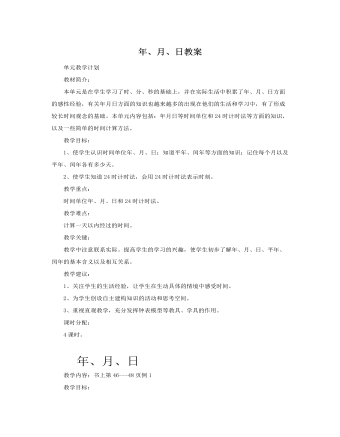
人教版新课标小学数学三年级下册年、月、日教案
大家请看,钟面上现在表示的是几时?(下午1时)下午1时我们还可以怎样表示?(13时)下午1时就是13时,你是怎么想到用13时表示的?在一日内,由于第一圈走了12小时,所以时针在走第二圈时,我们就要把时针指的钟面上的时刻数分别加上12,这就是我们今天要学习的24时记时法。比如,现在钟面上是下午1时,根据24时记时法就应该是?(13时)。那么下午2时、3时、6时、晚上7时30分、9时50分用24时计时法怎样表示?你是怎样想的?(继续看画面。)这时,同学们又开始了下午的学习生活。16时,同学们结束了一天的学习,回到了家中。时间一晃就到了21时,也就是我们常说的夜间九点。这时我们又该上床休息了。时间一分一秒地过去了,又是午夜12点,夜深人静,一天又过去了。这种用0时到24时来表示一天时间的记时方法我们就把它叫做24时记时法。师小结:同学们,一天的时间很快就会过去,我们要珍惜时间,合理地安排好一天的作息时间。4、观察钟面:你发现了什么?(同一指针可以表示晚上12时、0时、24时。)抽几个时间板书。观察普通计时法和24时计时法,发现他们有什么区别呢?同桌之间互相交流一下。
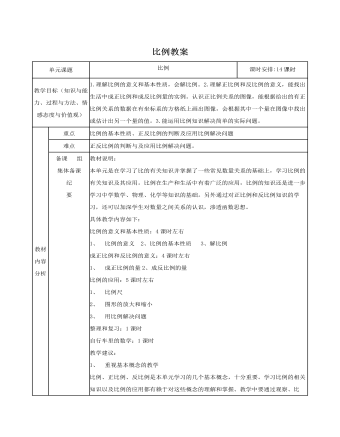
人教版新课标小学数学六年级下册比例教案
一、回顾旧知,复习铺垫1、上节课我们学习了一些比例的知识,谁能说一说什么叫做比例?比例的基本性质是什么?应用比例的基本性质可以做什么?2、判断下面每组中的两个比是否能组成比例?为什么?6:3和8:4 : 和 :3、这节课我们继续学习有关比例的知识,学习解比例。(板书课题)二、引导探索,学习新知1、什么叫解比例?我们知道比例共有四项,如果知道其中的任何三项,就可以求出这个比例中的另外一个未知项。求比例中的未知项,叫做解比例。解比例要根据比例的基本性质来解。2、教学例2。(1)把未知项设为X。解:设这座模型的高是X米。(2)根据比例的意义列出比例:X:320=1:10(3)让学生指出这个比例的外项、内项,并说明知道哪三项,求哪一项。根据比例的基本性质可以把它变成什么形式?3x=8×15。这变成了什么?(方程。)教师说明:这样解比例就变成解方程了,利用以前学过的解方程的方法就可以求出未知数X的值。
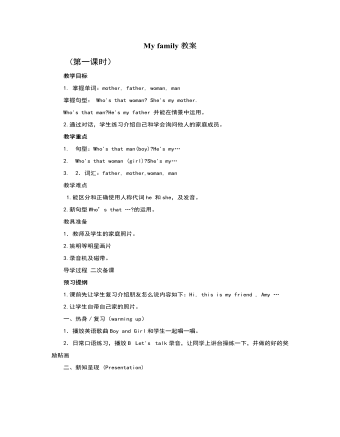
人教版新课标PEP小学英语三年级下册My family教案
1.能够听、说、读、写字母H h, Ii,并能听说认读以这些字母为首字母的单词:hamburger, hot dog ,ice-cream, ice.2.听懂Let’s do 中的字母和短语,并做出相应的动作。如:A B C, look and see.3.听懂Story time 的内容。教学重点 掌握字母H h, I i单词:hamburger, hot dog ,ice-cream, ice。教学难点 1.能够听懂一些指令性短语,并做出相应的动作。2. Story time 的内容教具准备 1.本课时相关的单词卡和图片2. 教材相配套的教学录音带导学过程 二次备课预习提纲1. 课前了解一些食物英语的名称。2. 课前先让学生复习三年级上册FoodPart A Let’s Learn 部分的单词:cake ,bread, chicken…一.热身/复习(warming up)1. 游戏:找朋友将学过的七个字母按大小写分开,一部分学生拿大写字母卡,一部分拿小写字母卡。让拿大写字母卡的学生分别起立读出手中的字母,那对应小写字母卡的学生跟到他前方举起手中的字母,说:I’m… 两人握手2.让学生听三年级上册Part A Let’s Learn部分的录音,了解相关的食物的名称。.
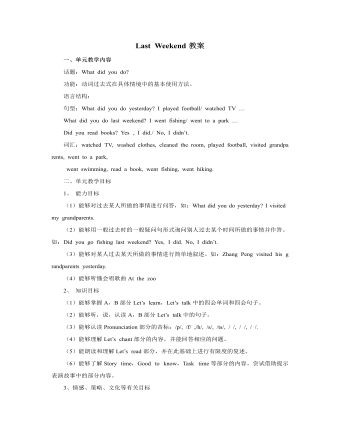
人教版新课标PEP小学英语六年级下册Last Weekend教案
一、教学内容:Part B Let’s learn Let’s play. Part C Task time Let’s check 二、教学目标与要求 1、掌握四会词组:went to a park, went swimming, read a book, went fishing, went hiking. 2、学会用句型What did you/ (name) do last weekend/ yesterday? I(name) (did) last weekend/ yesterday. Did you….? Yes, I did. 来进行问答并完成Task time的表格。 三、教学重点 掌握四会词组,并用所学词组和句型进行调查 四、教学难点 掌握四会词组(不规则动词过去式变化),并用所学词组和句型进行调查 五、课前准备 1、教师准备所需的词卡及图片。 2、学生准备词卡。 六、教学过程 1、Warm-up 1) Free-talk: T: What day is today? A: Today is… T: What day was yesterday? (强调 yesterday) B: Yesterday/ It was… T: What did you do yesterday? C: I (did)…yesterday. ( 用前几课时已经学的词组) 2) Chain-drill: C: I (did)…yesterday. What did you do yesterday? D: I (did)…yesterday. What did you do yesterday? E, F… (ask the teacher) T: I went to a park yesterday. 2、Presentation and practice let’s learn (1)继续Chain-drill,由T 引出并出示新授词组:went hiking. (2)学生已经了解了go 的过去式后, T 边用I went ( 这个动词用动作表示)yesterday.表达自己昨天去做什么了,边做动作.让学生帮老师说出: went swimming, went fishing.
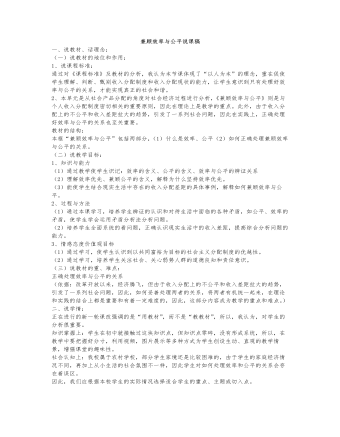
人教版高中政治必修1兼顾效率与公平说课稿
(3)如何做到兼顾效率与公平?这部分知识点我结合上面的图片,设疑:“请大家对这一社会现象进行讨论,我们如何才能做到既坚持效率又兼顾公平?”导入这部分的分析。学生在讨论的过程中对如何兼顾效率与公平已经形成了一定的见解,结合图片,为兼顾效率与公平献计献策,寻求两者的最佳结合点。幻灯片展示:怎样才能做到兼顾效率与公平?第一,允许和鼓励一部分地区和个人通过诚实劳动和合法经营先富起来,带动其他地区和个人致富,最终达到共同富裕。第二,既要反对平均主义,又要防止收入差距悬殊。既要落实分配政策,又要提倡奉献精神;在鼓励人们创业致富,提倡回报社会和先富帮后富。第三,必须正确处理初次分配注重效率与再次分配注重公平的关系。在讲授过程中,还展示大量图片。结合图片分析。设计意图:体现课堂上学生的主体地位,让学生在观看中体验,在讨论中升华,从而体会构建和谐社会的重要意义。
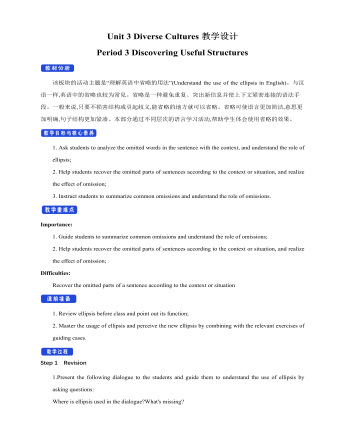
新人教版高中英语必修3Unit 3 Diverse Cultures教学设计三
The price is the same as(the price was)before the war.价格与战前相同。(4)定语从句中的“关系代词+助动词be”可以省略。The ticket(that/which was)booked by his sister has been sent to him.他妹妹订的那张票已送到了他那里。Step 5 PracticeActivity 3(1) Guide students to complete the four activities in the Using Structures part of exercise book, in which activities 1 and 2 focus on ellipsis in dialogue answers, activity 3 focus on signs and headlines, two typical situations where ellipsis is used, and activity 4 focus on ellipsis in diary, an informal style.(2) Combine the examples in the above activities, ask students to summarize the omitted situations in groups, and make their own summary into a poster, and post it on the class wall after class to share with the class.(This step should give full play to the subjectivity of students, and teachers should encourage students to conclude different ellipsis phenomena according to their own understanding, they can conclude according to the different parts omitted in the sentence.)Step 6 Homework1. Understand and master the usages of ellipsis;2. Finish the other exercises in Using structures of Workbook.1、通过本节内容学习,学生是否理解和掌握省略的用法;2、通过本节内容学习,学生能否根据上下文语境或情景恢复句子中省略的成分,体会使用省略的效果;3、通过本节内容学习,学生能否独立完成练习册和导学案中的相关练习。
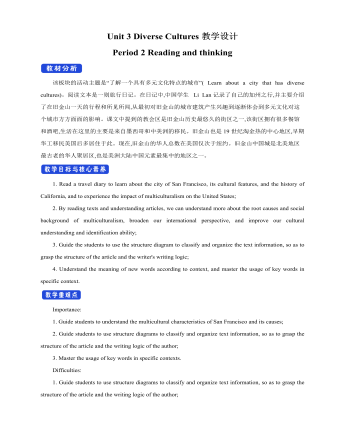
新人教版高中英语必修3Unit 3 Diverse Cultures教学设计二
(2)Consolidate key vocabulary.Ask the students to complete the exercises of activity 6 by themselves. Then ask them to check the answers with their partners.(The first language:Damage of the 1906 San Francisco earthquake and fire.A second language: Yunnan - one of the most diverse provinces in China).Step 5 Language points1. The teacher asks the students to read the text carefully, find out the more words and long and difficult sentences in the text and draw lines, understand the use of vocabulary, and analyze the structure of long and difficult sentences.2. The teacher explains and summarizes the usage of core vocabulary and asks the students to take notes.3. The teacher analyzes and explains the long and difficult sentences that the students don't understand, so that the students can understand them better.Step 6 Homework1. Read the text again, in-depth understanding of the text;2. Master the use of core vocabulary and understand the long and difficult sentences.3. Complete relevant exercises in the guide plan.1、通过本节内容学习,学生是否理解和掌握阅读文本中的新词汇的意义与用法;2、通过本节内容学习,学生能否结合文本特点了解文章的结构和作者的写作逻辑;3、通过本节内容学习,学生能否了解旧金山的城市风貌、文化特色,以及加利福尼亚州的历史,体会多元文化对美国的影响。
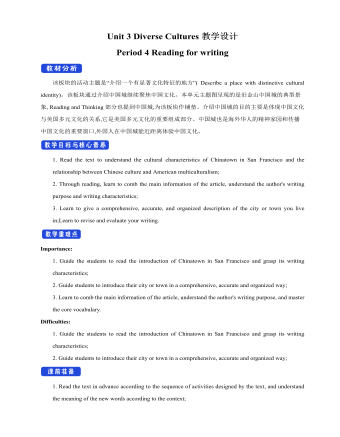
新人教版高中英语必修3Unit 3 Diverse Cultures教学设计四
该板块的活动主题是“介绍一个有显著文化特征的地方”( Describe a place with distinctive cultural identity)。该板块通过介绍中国城继续聚焦中国文化。本单元主题图呈现的是旧金山中国城的典型景象, Reading and Thinking部分也提到中国城,为该板块作铺垫。介绍中国城的目的主要是体现中国文化与美国多元文化的关系,它是美国多元文化的重要组成部分。中国城也是海外华人的精神家园和传播中国文化的重要窗口,外国人在中国城能近距离体验中国文化。1. Read the text to understand the cultural characteristics of Chinatown in San Francisco and the relationship between Chinese culture and American multiculturalism;2. Through reading, learn to comb the main information of the article, understand the author's writing purpose and writing characteristics;3. Learn to give a comprehensive, accurate, and organized description of the city or town you live in;Learn to revise and evaluate your writing.Importance:1. Guide the students to read the introduction of Chinatown in San Francisco and grasp its writing characteristics;2. Guide students to introduce their city or town in a comprehensive, accurate and organized way;3. Learn to comb the main information of the article, understand the author's writing purpose, and master the core vocabulary.
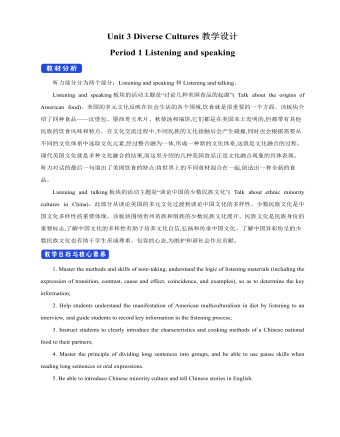
新人教版高中英语必修3Unit 3 Diverse Cultures教学设计一
Activity 81.Grasp the main idea of the listening.Listen to the tape and answer the following questions:Who are the two speakers in the listening? What is their relationship?What is the main idea of the first part of the listening? How about the second part?2.Complete the passage.Ask the students to quickly review the summaries of the two listening materials in activity 2. Then play the recording for the second time.Ask them to complete the passage and fill in the blanks.3.Play the recording again and ask the students to use the structure diagram to comb the information structure in the listening.(While listening, take notes. Capture key information quickly and accurately.)Step 8 Talking Activity 91.Focus on the listening text.Listen to the students and listen to the tape. Let them understand the attitudes of Wu Yue and Justin in the conversation.How does Wu Yue feel about Chinese minority cultures?What does Justin think of the Miao and Dong cultures?How do you know that?2.learn functional items that express concerns.Ask students to focus on the expressions listed in activity. 3.And try to analyze the meaning they convey, including praise (Super!).Agree (Exactly!)"(You're kidding.!)Tell me more about it. Tell me more about it.For example, "Yeah Sure." "Definitely!" "Certainly!" "No kidding!" "No wonder!" and so on.4.Ask the students to have conversations in small groups, acting as Jsim and his friends.Justin shares his travels in Guizhou with friends and his thoughts;Justin's friends should give appropriate feedback, express their interest in relevant information, and ask for information when necessary.In order to enrich the dialogue, teachers can expand and supplement the introduction of Miao, dong, Lusheng and Dong Dage.After the group practice, the teacher can choose several groups of students to show, and let the rest of the students listen carefully, after listening to the best performance of the group, and give at least two reasons.
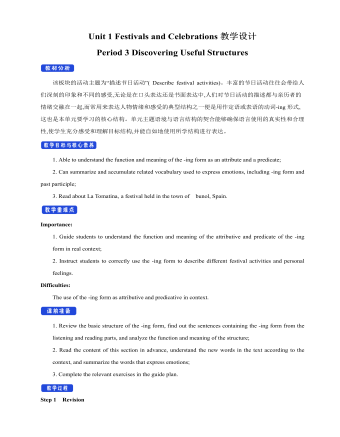
新人教版高中英语必修3Unit 1 Festivals and Celebrations教学设计二
1. Ss look at the picture and scan the passage to understand the main idea while teacher is giving the following questions to inspire Ss to think.*Where are those people?*What are they doing?*Why are they so excited?2. Ss complete the passage with the appropriate -ing form. Then discuss and check the answers with class.Answers: boring, interesting, taking, exciting, amazing3. The teacher raises questions for the students to discuss and encourages them to express their opinions.*Do you like La Tomatina? Why or why not?4. Each group representative reports the discussion result, the teacher gives feedback and the evaluation.Step 6 PracticeActivity 41. Ss complete the Ex 2 in Using structures.2. Check the answers after finishing the exercises.①The dragon boat races are the most exciting part of the Dragon Boat Festival.② The children were excited to go Easter egg hunting.③What an amazing performance! This is the best music festival I have ever been to.④We were amazed by her funny-looking hat.⑤His inspiring speech at the conference won the admiration/ favour of the audience.⑥This is a challenging game to test your memory and observation capabilities. 3. T asks Ss to finish Ex 3 and 4 in Using structures by themselves, then check the answers with class.Step 6 Homework1. Understand and master the functions and usage of the -ing form;2. Finish the other exercises in Using structures.1、通过本节内容学习,学生是否理解和掌握动词-ing形式作定语和表语的功能和意义;2、通过本节内容学习,学生能否在理解文段内容的基础上,根据上下文语境和表达逻辑,能正确运用动词-ing形式描述节日庆典。3、通过本节内容学习,学生是否归纳和积累用于表达情绪的相关词汇。
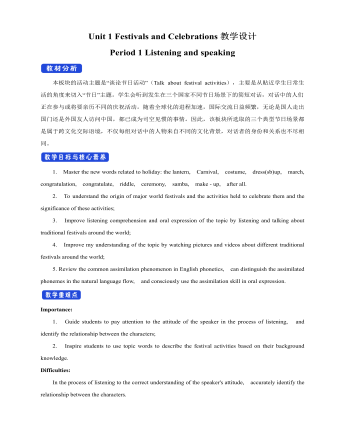
新人教版高中英语必修3Unit 1 Festivals and Celebrations教学设计一
本板块的活动主题是“谈论节日活动”(Talk about festival activities),主要是从贴近学生日常生活的角度来切入“节日”主题。学生会听到发生在三个国家不同节日场景下的简短对话,对话中的人们正在参与或将要亲历不同的庆祝活动。随着全球化的进程加速,国际交流日益频繁,无论是国人走出国门还是外国友人访问中国,都已成为司空见惯的事情。因此,该板块所选取的三个典型节日场景都是属于跨文化交际语境,不仅每组对话中的人物来自不同的文化背景,对话者的身份和关系也不尽相同。1. Master the new words related to holiday: the lantern, Carnival, costume, dress(sb)up, march, congratulation, congratulate, riddle, ceremony, samba, make - up, after all. 2. To understand the origin of major world festivals and the activities held to celebrate them and the significance of these activities;3. Improve listening comprehension and oral expression of the topic by listening and talking about traditional festivals around the world;4. Improve my understanding of the topic by watching pictures and videos about different traditional festivals around the world;5. Review the common assimilation phenomenon in English phonetics, can distinguish the assimilated phonemes in the natural language flow, and consciously use the assimilation skill in oral expression. Importance:1. Guide students to pay attention to the attitude of the speaker in the process of listening, and identify the relationship between the characters;2. Inspire students to use topic words to describe the festival activities based on their background knowledge. Difficulties:In the process of listening to the correct understanding of the speaker's attitude, accurately identify the relationship between the characters.
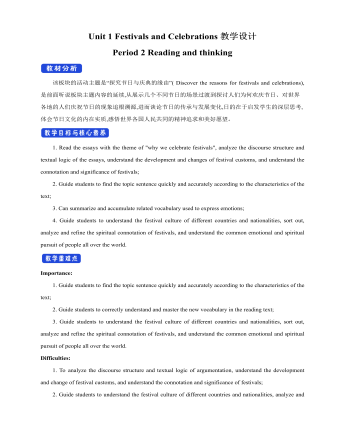
新人教版高中英语必修3Unit 1 Festivals and Celebrations教学设计三
*wide range of origins(= a great number of different origins, many kinds of origins)*It featured a parade and a great feast with music, dancing, and sports. (=A parade and a great feast with music, dancing, and sports were included as important parts of the Egyptian harvest festival.)*.. some traditions may fade away and others may be established.(= Some traditions may disappear gradually, while other new traditions may come into being.)Step 6 Practice(1) Listen and follow the tape.The teacher may remind the students to pay attention to the meaning and usage of the black words in the context, so as to prepare for the completion of the blanks in activity 5 and vocabulary exercises in the exercise book.(2) Students complete the text of activity 5 by themselves.The teacher needs to remind the students to fill in the blanks with the correct form of the vocabulary they have learned in the text.Students exchange their answers with their partners, and then teachers and students check their answers.(3)Finish the Ex in Activity 5 of students’ book.Step 7 Homework1. Read the text again, in-depth understanding of the text;2. Discuss the origin of festivals, the historical changes of related customs, the influence of commercial society on festivals and the connotation and essential meaning of festivals.3. Complete relevant exercises in the guide plan.1、通过本节内容学习,学生是否理解和掌握阅读文本中的新词汇的意义与用法;2、通过本节内容学习,学生能否结合文本特点快速而准确地找到主题句;3、通过本节内容学习,学生能否理清论说文的语篇结构和文本逻辑,了解节日风俗发展与变迁,感悟节日的内涵与意义。
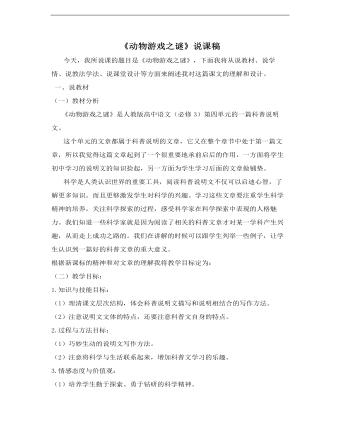
高中语文人教版必修三《动物游戏之谜》说课稿
科学是人类认识世界的重要工具,阅读科普说明文不仅可以启迪心智,了解更多知识。而且更够激发学生对科学的兴趣。学习这些文章要注重学生科学精神的培养,关注科学探索的过程,感受科学家在科学探索中表现的人格魅力。我们知道一些科学家就是因为阅读了相关的科普文章才对某一学科产生兴趣,从而走上成功之路的。我们在讲解的时候可以跟学生列举一些例子,让学生认识到一篇好的科普文章的重大意义。

人教版高中生物必修1细胞增殖说课稿
f.有丝分裂的意义(讨论分析教学),首先引导学生结合所学知识讨论有丝分裂的的作用,最后有教师归纳总结,并要求学生在理解的基础上记忆。g.无丝分裂(图形直观教学、简介),本部分内容不是教学的重点,内容也相对简单,所以我的教学方法是直接给学生展示挂图,再进行简短介绍,让学生了解即可。h.引出减数分裂的概念,为第五章学习打下基础。小结:新课讲完以后由教师对本节内容进行总结巩固和反馈:进行一些课堂练习达到巩固和反馈的作用。最后布置作业,各种难度的作业题目均设置一些,其中简单题比重大,难题要求学生选作,这样提高学生学习积极性。2教学媒体程序设计: 细胞周期的概念(多媒体课件演示周期动画)植物细胞有丝分裂(多媒体课件演示分裂各期动画)动植物细胞有丝分裂异同点(多媒体课件演示分裂各期动画)有丝分裂过程中DNA和染色体数量的变化规律(挂图演示,包括表格和函数图象)
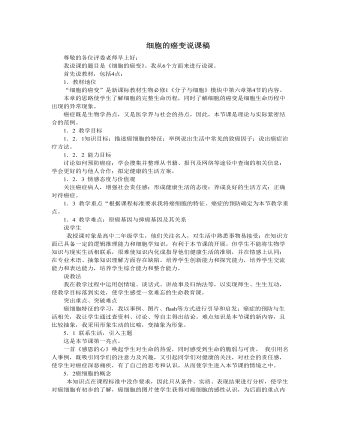
人教版高中生物必修1细胞的癌变说课稿
5.5癌症的预防作为本节最重要内容,且与生活息息相关,我采用老师引导、学生讨论总结的方法进行教学。从生活各方面总结出保健良方 ,既对知识有很好应用,又体现对生命的热爱。此时,本节课达到高潮,同学们意气风发,热烈讨论,实现本节课的教学目标。5.6 癌症的治疗通过讲述癌症治疗方法的副作用,激发学生探究生物学欲望,激励学生立志除癌。 在此,我选用一则关于一名癌症晚期病人运用心理疗法成功战胜癌症的故事,在于对不同层次的学生进行多方面启发教育,体现面向全体学生的课程理念。5.7 愉悦总结,及时反馈本节知识点零散,我将带领学生回忆浏览本节内容,使零散知识点系统化。在课堂反馈环节,我通过简单练习采用分组竞答的方式把握学生对知识的掌握程度,并给予表现突出的学生适当奖励,这是本节课第三个亮点。竞答既使课堂显得紧凑、集中,又有利于形成学生的竞争意识,还使得学生的知识得以巩固应用。
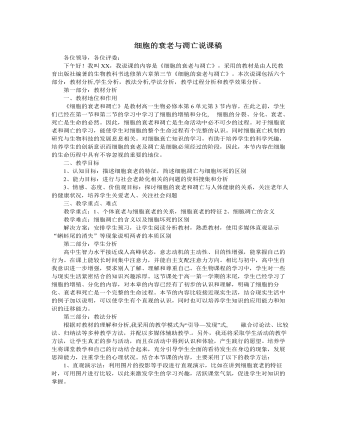
人教版高中生物必修1细胞的衰老与凋亡说课稿
4、最后从生物的寿命引入,探讨细胞的死亡。强调细胞死亡有两种形式。(1).细胞坏死,它是由某些外界因素造成细胞急速死亡,是一种被动性死亡;(2).细胞凋亡,这是一种由特定基因控制的主动性死亡。细胞坏死与细胞凋亡在形态学和生物化学上有着明显的区别。细胞凋亡有广泛的生物学意义,比如胚胎发育期手的发育如果没有细胞的调亡就不会有纤细的手指;如果没有正常的细胞调亡,蝌蚪的尾部就不会消失,它将永远不能变成青蛙……。正常的细胞调亡还肩负着维持各种组织器官固有体积和形态的功能;还会使机体内异常的细胞得到及时清除,去处潜在的隐患;例如癌症就是异常的细胞没有及时死亡的结果……。因此细胞的正常死亡是生物体的一种非常重要的调节机制,是机体平衡细胞增殖,调节机体细胞树木恒定的方式,是必不可少的生命过程。(15分钟)5、课堂小结,可以把课堂传授的知识尽快地转化为学生的素质;简单扼要的课堂小结,可使学生更深刻地理解政治理论在实际生活中的应用,并且逐渐地培养学生具有良好的个性。
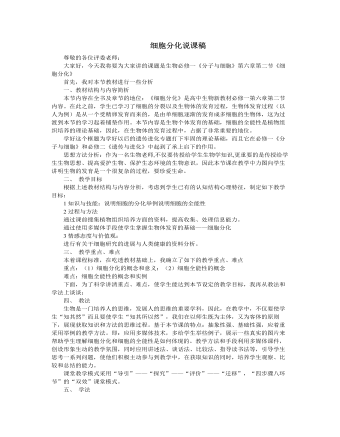
人教版高中生物必修1细胞分化说课稿
在讲述细胞分化的意义时,也可以用实例来解决,工厂的生产车间里不同的工人干着不同的工作,一件产品的产出需要这些工人才能创造出来,一个生物体就像一个车间一样,不同的细胞各司其职,相互合作。工人的分工是主管调解出来的,而不同细胞的出现就是细胞分化的结果,所以说,细胞的分化是生物体发育的基础。在讲到细胞全能性的时候,要多给学生举些关于细胞全能性的例子,如植物组织培养、克隆技术等等,让学生从实际的例子中真正的悟出细胞全能性的含义。此外,还要重视教材中的疑问,适当对题目进行引申,使它的作用更加突出,有利于学生对知识的串联、积累、加工,从而达到举一反三的效果。怎样来解释细胞的全能性呢?这主要以讲授法来解释了,细胞全能性的体现需要在组织或器官离体后才能体现出来,每个细胞都包含着生物体的全套遗传基因,通过基因选择性的表达,使离体的组织或器官通过分裂和分化逐渐发育成完整的植株。
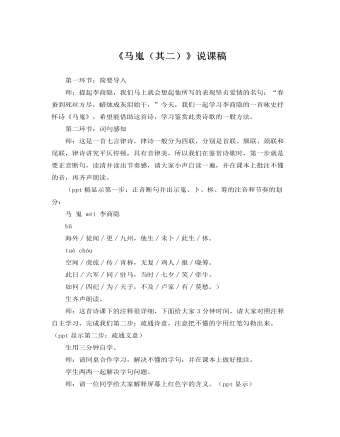
人教版高中语文必修3《马嵬(其二)》说课稿
生2:颔联的意思是只听到禁卫军中传来夜间巡逻的梆子声,不再向宫中那样安逸地听到有鸡人打鸣报时的声音了。生3:颈联的意思是说事变发生那天军队发生哗变停留不前,但当年唐玄宗以为自己可以和贵妃天天在一起,对天上的牵牛和织女一年一度的会见还加以嘲笑呢。生4:尾联的含义是为什么唐玄宗当了四十五年的皇帝,还不如普通百姓夫妻恩爱,长相厮守。师:好的。请大家再齐读一遍诗文,做到人人都能疏通诗的含义。学生再次齐读。第三环节:专项探究师:白居易曾说:“文章合为时而著,歌诗合为事而作。”这首诗就是作者途经马嵬驿,咏马嵬之变这一历史事件而作,所以我们鉴赏的第三步,就是通过标题和诗文,弄清诗中的历史事件。请同学们找出诗中哪些诗句描述了这一事件?
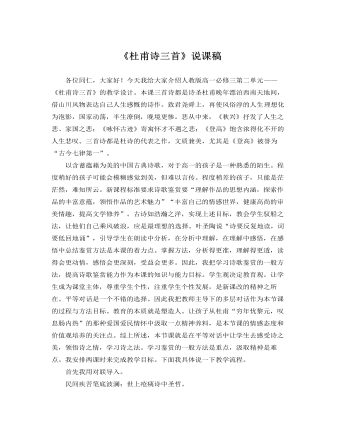
人教版高中语文必修3《杜甫诗三首》说课稿
我以以《登高》为例,引导学生进行意象分析,感悟意境美。古人云“立象以尽意”“古诗之妙,专求意象”意象是诗人情感的载体,是诗歌的灵魂。引导学生张开联想和想象的翅膀去感受,去体验是意象,诗歌鉴赏的关键。科林伍德说“真正艺术的作品,不是看见的,也不是听到的,而是想象中的某种东西。”诗人通过想象创造出诗的形象,我们读者通过想象丰富地再现诗人创造的形象。而感受体验则是以全部身心投入作品,心灵与心灵相沟通,感情与感情相交流,对诗人的想象活动进行再经历和再体验。因此,在引导意象解读中,我先让学生点击这一个,就是通过抓修饰词、依据感情基调、展开想象具体分析本诗中每个意象的情感意蕴和审美意蕴,使学生明白意象在每首诗中的独特性。
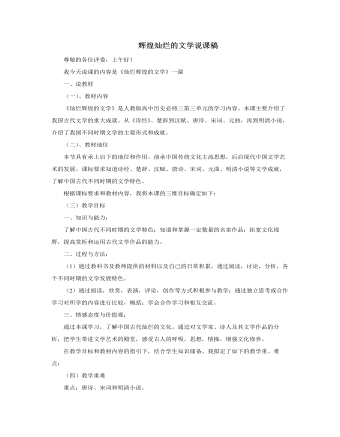
人教版高中历史必修3辉煌灿烂的文学说课稿
教师:不同的时代造就了不同风格和不同精神内容的诗词,请同学们回顾必修一和必修二两宋中央集权的加强和经济的发展状况。学生:回忆回答。教师:请同学们结合时代背景和词的特点理解词为什么能够成为宋代文学的主流形式和标志?学生:两宋时经济重心转移到了南方,商业发展打破了时间和空间的限制,城市繁荣,市民数量不断增加。词的句子长短不齐,便于抒发感情,并且能够歌唱,更能适应市井生活的需要。于是,词成为宋代文学的主流形式和标志。教师:宋代文人地位提高,宋词就是一个个时代的画卷:大宋的悲欢离合都写在了里面。除了词之外,宋代民间还兴起了一种新的诗歌形式,即散曲。学生:回答散曲的发展阶段及特点、元曲的含义、特点。教师:在中国古代诗歌辉煌发展的同时,也产生了供人们闲来无事消遣的小说。





















